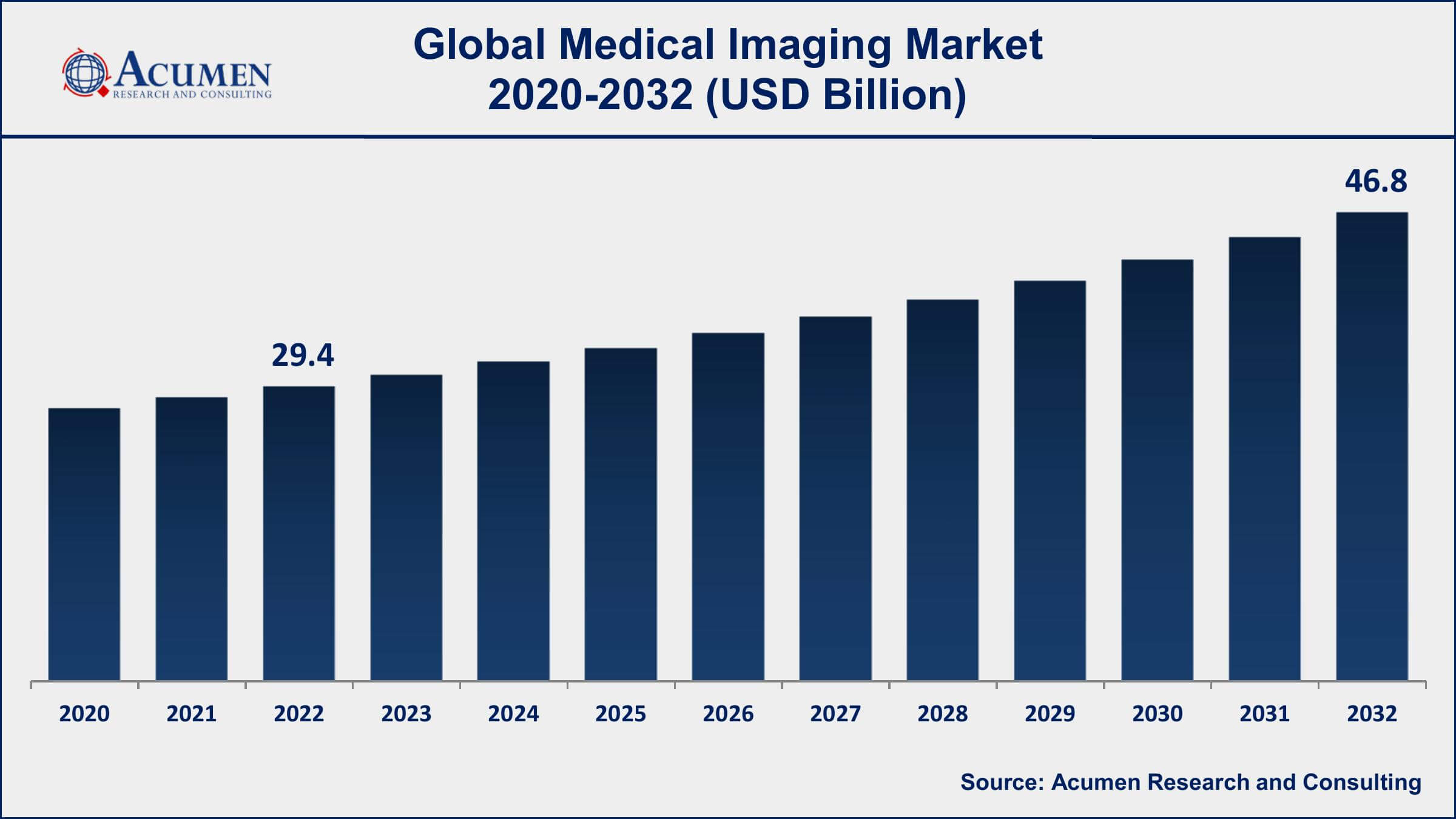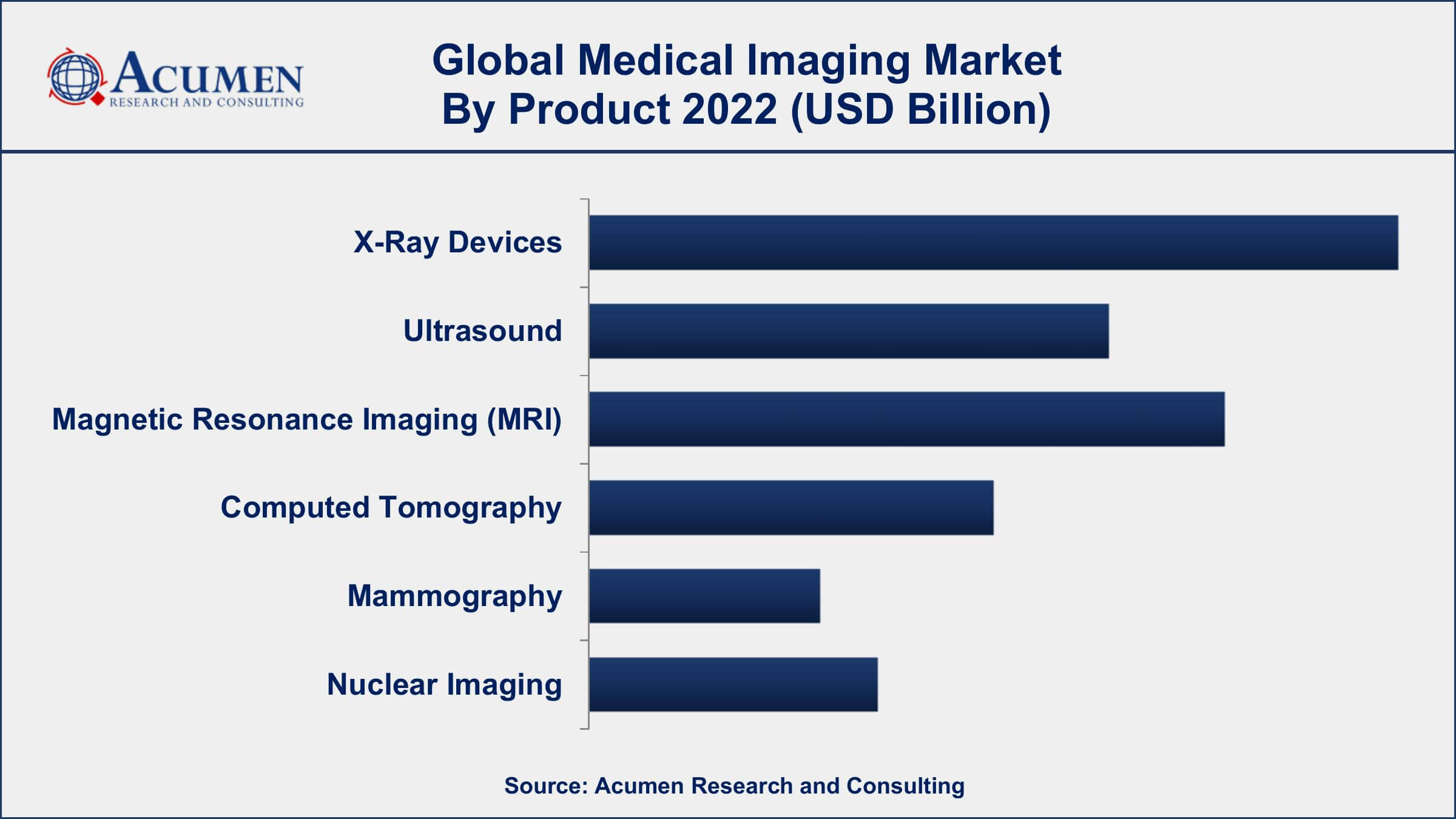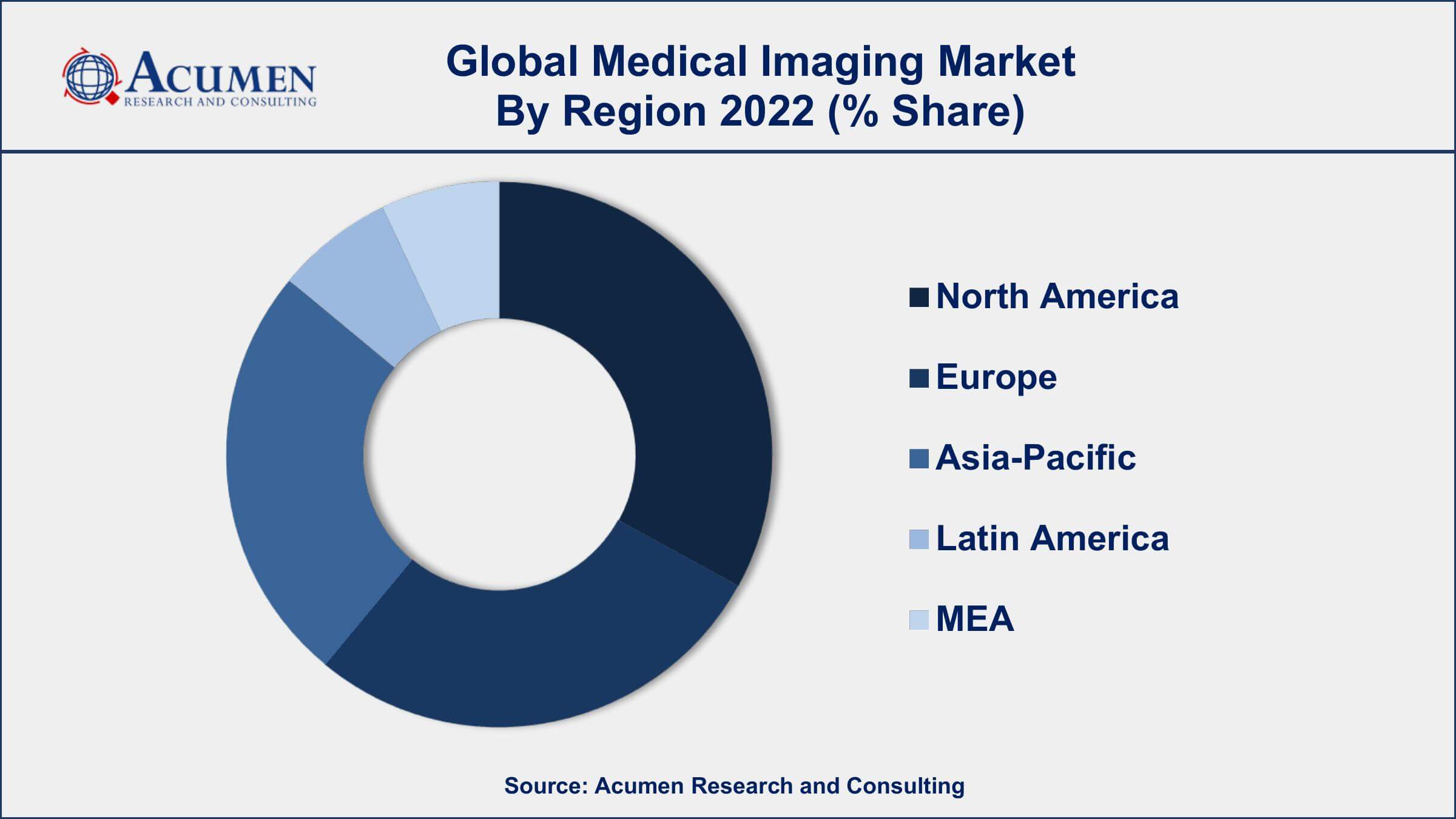Medical Imaging Market Size - Global Industry, Share, Analysis, Trends and Forecast 2023 - 2032
Published :
Report ID:
Pages :
Format :
Medical Imaging Market Size - Global Industry, Share, Analysis, Trends and Forecast 2023 - 2032
Report Coverage
- Industry Dynamics
- Market Size and Forecast Data
- Segment Analysis
- Competitive Landscape
- Regional Analysis with a Niche Focus on Country-Level Data
- High Level Analysis - Porter's, PESTEL, Value Chain, etc.
- Company Profiles of Key Players
- Option to Customize the Report As Per Your Specific Need
Request Sample Report
The Global Medical Imaging Market Size accounted for USD 29.4 Billion in 2022 and is projected to achieve a market size of USD 46.8 Billion by 2032 growing at a CAGR of 4.8% from 2023 to 2032.
Report Key Highlights
- Global medical imaging market revenue is expected to increase by USD 46.8 Billion by 2032, with a 4.8% CAGR from 2023 to 2032
- North America region led with more than 34% of medical imaging market share in 2022
- According to the National Institutes of Health, medical imaging is responsible for over 70% of all medical decisions made by doctors
- According to the study, approximately 7.5 million obstetric ultrasounds are conducted in the United States alone each year
- Radiography is one of the oldest and most widely utilized imaging modalities, with over 3.5 billion X-ray exams performed worldwide each year
- MRI scans are the fastest-growing imaging modality, with a CAGR of 6.2% from 2023 to 2032
- Growing demand for minimally invasive procedures, drives the medical imaging market size

Medical imaging refers to the use of technology and techniques to create visual representations of the interior of the body for medical purposes. Medical imaging techniques include X-rays, computed tomography (CT), magnetic resonance imaging (MRI), ultrasound, and nuclear medicine. These techniques are used to diagnose and monitor a wide range of medical conditions, such as cancer, heart disease, and neurological disorders.
The market for medical imaging has been growing steadily over the past few years and is projected to continue to do so in the coming years. The growth is being driven by a number of factors, including the aging population, increasing prevalence of chronic diseases, technological advancements in imaging equipment, and rising demand for minimally invasive procedures. In addition, increasing investments in research and development, and the development of new imaging modalities are also expected to contribute to the growth of the medical imaging market.

Global Medical Imaging Market Trends
Market Drivers
- Increasing prevalence of chronic diseases, such as cancer, cardiovascular diseases, and neurological disorders
- Advancements in medical imaging technology and equipment
- Growing demand for minimally invasive procedures
- Aging population leading to higher demand for diagnostic imaging services
- Rising healthcare expenditure and investment in healthcare infrastructure
Market Restraints
- High cost of medical imaging equipment and procedures
- Lack of skilled professionals to operate and interpret medical imaging results
Market Opportunities
- Growing demand for point-of-care imaging in remote and underserved areas
- Adoption of artificial intelligence and machine learning in medical imaging analysis
Medical Imaging Market Report Coverage
| Market | Medical Imaging Market |
| Medical Imaging Market Size 2022 | USD 29.4 Billion |
| Medical Imaging Market Forecast 2032 | USD 46.8 Billion |
| Medical Imaging Market CAGR During 2023 - 2032 | 4.8% |
| Medical Imaging Market Analysis Period | 2020 - 2032 |
| Medical Imaging Market Base Year | 2022 |
| Medical Imaging Market Forecast Data | 2023 - 2032 |
| Segments Covered | By Product, By Application, By End User, And By Geography |
| Regional Scope | North America, Europe, Asia Pacific, Latin America, and Middle East & Africa |
| Key Companies Profiled | Siemens Healthineers, Mindray Medical International, GE Healthcare, Canon Medical Systems Corp., Koninklijke Philips N.V., Hologic, PerkinElmer Inc., Esaote, FUJIFILM VisualSonics Inc., Samsung Medison Co., Koning Corporation, and Cubresa Inc. |
| Report Coverage |
Market Trends, Drivers, Restraints, Competitive Analysis, Player Profiling, Covid-19 Analysis, Regulation Analysis |
Advancements in technology in diagnostic imaging devices as well as the increasing prevalence of chronic disorders along with the presence of a rapidly aging population, rising awareness for early diagnosis, and an increase in the number of medical imaging procedures are some of the key factors driving the growth of global medical imaging market value. Also, untapped medical imaging procedures in LAMEA and Asia-Pacific regions are also projected to fuel the overall market growth over the forecast period. Although, the high cost of imaging modalities, shortage of helium gas, and unfavorable reimbursement scenario especially in emerging economies are anticipated to limit the market growth. However, increasing healthcare spending will continue to propel the demand for medical imaging devices over the forecast period. Medical practitioners extensively use diagnostic imaging technologies to diagnose and check patients and provide exact medical conditions.
Widespread use of diagnostic imaging procedures including X-ray, MRI, and CT scans has witnessed significant growth over the past few decades. These imaging procedures offer rapid diagnosis and are painless, thus making them a suitable option for doctors and patients alike. Growing awareness towards preventative care has in turn resulted in rising demand for medical imaging techniques. In addition, the burgeoning aging population is another key factor fuelling the overall global medical imaging market growth.

Medical Imaging Market Segmentation
The global medical imaging market segmentation is based on product, application, end user, and geography.
Medical Imaging Market By Product
- X-Ray Devices
- Analog
- Digital
- Computed Radiography Systems
- Direct Radiography Systems
- Ultrasound
- 2D Ultrasound
- 3D Ultrasound
- Others
- Magnetic Resonance Imaging (MRI)
- Computed Tomography
- Mammography
- Nuclear Imaging

According to the medical imaging industry analysis, the x-ray devices segment accounted for the largest market share in 2022. X-ray devices are one of the oldest and most widely used medical imaging modalities. This is used to diagnose and monitor a variety of medical conditions, such as fractures, infections, and lung diseases. One of the key drivers of growth in the X-ray devices segment is the increasing prevalence of chronic diseases, which is leading to higher demand for diagnostic imaging services. In addition, the aging population and growing preference for non-invasive diagnostic procedures are also contributing to the growth of the X-ray devices market. Advancements in X-ray technology, such as the development of digital X-ray systems, are also expected to drive growth in the market, as these systems offer improved image quality and reduced radiation exposure for patients.
Medical Imaging Market By Application
- Obstetrics and Gynecology Health
- General Imaging
- Neuro and Spine
- Orthopedics and Musculoskeletal
- Cardiovascular and Thoracic
- Breast Health
- Oncology
- Urology
- Others
In terms of applications, the obstetrics and gynecology health segment is expected to witness significant growth in the coming years. Medical imaging techniques, such as ultrasound and MRI, are widely used in obstetrics and gynecology (OB/GYN) to diagnose conditions such as uterine fibroids, ovarian cysts, and breast cancer. One of the key drivers of growth in the OB/GYN medical imaging segment is the increasing awareness and importance of women's health, leading to higher demand for diagnostic imaging services. In addition, advancements in medical imaging technology, such as 3D and 4D ultrasound, are also contributing to the growth of the OB/GYN segment. Rising healthcare expenditure and investment in healthcare infrastructure, particularly in emerging economies, are also expected to drive growth in the market.
Medical Imaging Market By End User
- Hospitals
- Diagnostic imaging centers
- Others
According to the medical imaging market forecast, the hospital segment is expected to witness significant growth in the coming years. Hospitals are a key segment of the medical imaging market, as they are the primary users of medical imaging equipment and services. Hospitals use medical imaging technologies, such as X-ray, CT scan, MRI, and ultrasound, to diagnose and monitor a wide range of medical conditions. One of the key drivers of growth in the hospital segment is the increasing prevalence of chronic diseases and the growing demand for diagnostic imaging services. In addition, advancements in medical imaging technology, such as the development of digital imaging systems, are also contributing to the growth of the hospital segment. The aging population and the rising number of diagnostic imaging procedures performed in hospitals are also expected to drive growth in the market.
Medical Imaging Market Regional Outlook
North America
- U.S.
- Canada
Europe
- U.K.
- Germany
- France
- Spain
- Rest of Europe
Asia-Pacific
- India
- Japan
- China
- Australia
- South Korea
- Rest of Asia-Pacific
Latin America
- Brazil
- Mexico
- Rest of Latin America
The Middle East & Africa
- South Africa
- GCC Countries
- Rest of the Middle East & Africa (ME&A)

Medical Imaging Market Regional Analysis
North America dominates the medical imaging market due to a range of factors. One of the key factors is the high prevalence of chronic diseases in the region, such as cancer, cardiovascular disease, and respiratory disease. This has led to a high demand for diagnostic imaging services and a large installed base of medical imaging equipment in the region. In addition, North America has a well-established healthcare infrastructure and a high level of healthcare expenditure, which supports the adoption and utilization of medical imaging technologies. Another factor contributing to North America's dominance in market is the strong presence of key market players in the region. Many leading manufacturers of medical imaging equipment are based in North America and have a significant market share in the region. This has led to a high level of innovation and development of new imaging technologies in the region, which has further driven market growth.
Medical Imaging Market Player
Some of the top medical imaging market companies offered in the professional report include Siemens Healthineers, Mindray Medical International, GE Healthcare, Canon Medical Systems Corp., Koninklijke Philips N.V., Hologic, PerkinElmer Inc., Esaote, FUJIFILM VisualSonics Inc., Samsung Medison Co., Koning Corporation, and Cubresa Inc.
Frequently Asked Questions
What was the market size of the global medical imaging in 2022?
The market size of medical imaging was USD 29.4 Billion in 2022.
What is the CAGR of the global medical imaging market from 2023 to 2032?
The CAGR of medical imaging is 4.8% during the analysis period of 2023 to 2032.
Which are the key players in the medical imaging market?
The key players operating in the global market are including Siemens Healthineers, Mindray Medical International, GE Healthcare, Canon Medical Systems Corp., Koninklijke Philips N.V., Hologic, PerkinElmer Inc., Esaote, FUJIFILM VisualSonics Inc., Samsung Medison Co., Koning Corporation, and Cubresa Inc.
Which region dominated the global medical imaging market share?
North America held the dominating position in medical imaging industry during the analysis period of 2023 to 2032.
Which region registered fastest CAGR from 2023 to 2032?
Asia-Pacific region exhibited fastest growing CAGR for market of medical imaging during the analysis period of 2023 to 2032.
What are the current trends and dynamics in the global medical imaging industry?
The current trends and dynamics in the medical imaging industry include increasing prevalence of chronic diseases, and growing demand for minimally invasive procedures.
Which end user held the maximum share in 2022?
The hospitals end user held the maximum share of the medical imaging industry.


